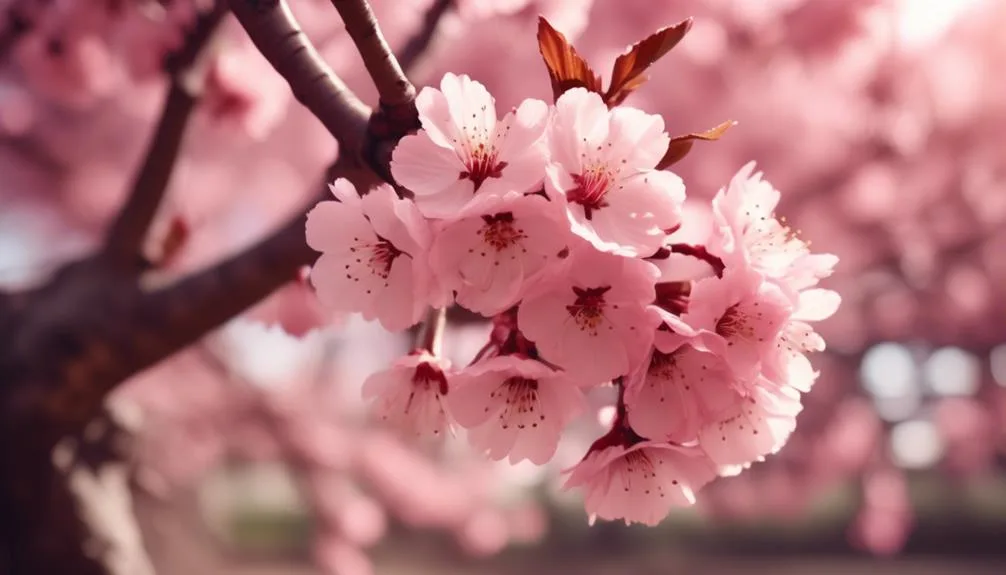Cherry trees have a brief but stunning bloom before fading away. Several factors, like disease vulnerability, environmental stress, and the strain of fruit production, play a role.
Understanding these reasons could help extend the life of these beautiful trees. This would allow for longer enjoyment of their delicate blossoms.
Disease Susceptibility
Cherry trees are highly susceptible to various diseases, which can significantly impact their overall health and lifespan.
Fungal infections and bacterial susceptibility pose significant threats to these trees. Fungi such as brown rot and powdery mildew can quickly spread and weaken the tree's ability to produce fruit. Additionally, bacterial canker can cause dieback of shoots and even kill entire branches.
Pest vulnerability is another challenge, with pests like aphids and mites causing damage to cherry trees. Moreover, viruses can also impact cherry trees, affecting their growth and fruit quality.
Understanding these disease vulnerabilities is crucial for implementing effective preventive measures to protect the health and longevity of cherry trees.
Environmental Stressors
With cherry trees being highly susceptible to various diseases, it's important to also consider the impact of environmental stressors on their overall health and longevity.
Climate change can lead to extreme weather events like droughts or intense storms, which can stress cherry trees and make them more vulnerable to diseases. Additionally, changes in temperature and precipitation patterns can disrupt the delicate balance of the cherry tree's growth cycle, impacting their ability to thrive.
Soil quality plays a crucial role as well, as nutrient-poor or compacted soil can hinder the tree's root development and nutrient uptake.
Pollution, including air and water pollution, can also weaken cherry trees, making them more susceptible to diseases.
Lastly, urbanization and habitat loss can reduce the tree's access to vital resources, further adding to their environmental stress.
Genetic Factors
Genetic factors significantly influence the health and longevity of cherry trees, playing a crucial role in their ability to resist diseases and adapt to changing environmental conditions. Evolutionary adaptation has shaped the genetic makeup of cherry trees, allowing them to develop specific traits that enhance their survival in their natural habitats.
Over time, cherry trees have evolved to exhibit a diverse range of genetic characteristics, enabling them to thrive in various environmental conditions. Additionally, their reproductive strategy, which involves producing numerous seeds, contributes to genetic diversity within the population. This genetic diversity allows cherry trees to adapt to different climates and ecological niches, ensuring the survival of the species.
Understanding the genetic factors that influence cherry trees' lifespan is essential for conservation efforts and for developing strategies to improve their resilience to environmental stressors.
Fruit Production Strain
The strain of cherry trees selected for fruit production plays a crucial role in determining the quantity and quality of the harvest. When it comes to fruit production strain, several factors come into play:
- Pollination methods: Different strains may require specific pollination methods to optimize fruit production, such as cross-pollination or self-pollination.
- Soil nutrients: The strain of cherry trees may have varying soil nutrient requirements, impacting their ability to produce high-quality fruit.
- Climate adaptability: Some strains are better suited to specific climates, affecting their fruit production capacity.
- Disease resistance: Certain strains may be more resistant to common cherry tree diseases, preserving fruit quality and quantity.
- Fruit flavor and size: Different strains may yield varying fruit flavors and sizes, influencing their market desirability.
Selecting the right strain for fruit production is essential to ensure a bountiful and high-quality cherry harvest.
Cultivation Practices
To achieve optimal cherry tree cultivation, implementing proper pruning techniques is essential for promoting healthy growth and maximizing fruit production. Regular pruning helps remove dead or diseased branches, encourages new growth, and increases fruit-bearing wood.
When pruning, focus on removing weak or crossing branches to improve airflow and sunlight penetration. Additionally, maintaining proper soil nutrients is crucial for cherry tree health. Ensure the soil is well-draining and rich in organic matter. Regularly test the soil to adjust pH levels and provide necessary nutrients like nitrogen, phosphorus, and potassium.
Watering frequency is also vital. Cherry trees generally require consistent moisture, especially during dry periods and fruit development.
Lastly, consider pollination methods. Some cherry tree varieties may benefit from cross-pollination, while others are self-fertile.
Understanding these cultivation practices will help you foster healthy and productive cherry trees.
Conclusion
To extend the lifespan of cherry trees, addressing disease susceptibility, environmental stress, genetics, fruit production strain, and cultivation practices is crucial.
By understanding and managing these factors, gardeners and arborists can help ensure the long-term health and enjoyment of cherry trees.
How can we work together to overcome these challenges and preserve the beauty of cherry trees for generations to come?

My interest in trees started when I first saw the giant sequoias in Yosemite.
I was a teenager then, and I remember thinking, “I need to learn more about this.”
That moment stuck with me.
A few years later, I went on to study forestry at Michigan Tech.
Since graduating, I’ve worked in a mix of hands-on tree care and community education.
I’ve spent over ten years helping people understand how to plant, maintain, and protect the trees in their neighborhoods.
I don’t see trees as just part of the landscape.
They are living things that make a real difference in our daily lives.
